Energy Performance Certificate reform consultation: response
Our response to the 2023 Energy Performance Certificate (EPC) reform consultation. The response sets out our intentions to reform EPCs by introducing new ratings, redesigning the certificates, and improvements to the operational infrastructure.
3. EPC Rating System
In our consultation on EPC reform, we proposed changes to improve the EPC rating system for both domestic and non-domestic buildings.
3.1 Domestic EPCs
We Asked
We proposed to revise the information displayed on domestic EPCs by expanding the current ratings, renaming them to make their purpose clearer, and reporting other relevant information. This would provide a more holistic view to current and potential homeowners. We proposed to reform domestic EPC ratings to present the following headline set:
- Fabric Rating – setting out the current modelled fabric performance of the building in terms of its heat loss in standard conditions, in kWh/m2/year, calculated through the SAP assessment
- Heating System Type Rating – clearly identifying the main heating system installed in the dwelling and whether or not it is zero direct emissions, and rating the cost and thermal efficiency of the system
- Cost Rating – setting out the current modelled annual costs of running the building based on the SAP assessment, and how these costs could change as a result of measures recommended. This is the same as the Energy Efficiency Rating (EER) currently displayed on EPCs
Alongside these headline ratings, we also intended to report in a separate section:
- Emissions Rating – setting out the current modelled total emissions from the building in kgCO2e/m²/year. This is the same as the Environmental Impact Rating (EIR) currently displayed on EPCs.
- Energy Indicator – reporting the modelled energy use of the dwelling in kWh/m2/year.
In addition to ratings, we proposed to display the basic fabric energy efficiency features (such as whether the dwelling has cavity wall insulation or loft insulation) more prominently.
We asked the following questions on these proposals:
1. Do you agree with the set of metrics that we propose to display on the reformed EPC?
2. Are there additional metrics that you think should be included on the EPC, or metrics that you do not think should be included?
3. Considering our proposal to include a Fabric Rating on EPCs, do you think this metric should include domestic hot water heat demand?
4. Do you have a view on the way that the Fabric Rating mapped against a scale, for example, how ‘A’ or ‘G’ rated performance is determined?
5. Do you agree with our proposal to give more prominence to the energy efficiency features of the home (such as the depth of loft insulation)?
You Said
The consultation analysis published alongside this Scottish Government response highlighted the following key findings and themes given by respondents to the five questions above.
Key Findings
Across the questions asked in this section, many issues tended to emerge repeatedly. The main findings were as follows:
- Slightly greater numbers of respondents disagreed with the proposed set of ratings to display on the reformed EPC than agreed (Q1)
- Respondents requested more information on the costs and suitability of improvements as an addition to the ratings (Q2)
- A majority of respondents felt that the fabric rating should not include domestic hot water heat demand (Q3)
- General agreement with mapping the fabric rating against an ‘A-G’ scale (Q4)
- Majority agreement that more prominence should be given to the energy efficiency features of a home (Q5)
Key themes
- Supportive statements from organisations that the proposed set of ratings are sensible
- General agreement with the need to raise the profile of fabric efficiency, though difficult to quantify
- More disagreement than agreement with domestic hot water demand being included in the fabric rating. This was because of inconsistent data and the lack of a relationship to fabric heat losses
- Equal support for aligning the fabric rating A-G scale with the current energy efficiency rating (EER), and for setting the bands independently of the EER
Next most frequent themes
- General agreement with using a 0-100 rating for the energy cost rating as monetary values will vary over time
- Requests for a rating to reflect the overall carbon emissions and embodied carbon
- Disagreements with including, or suggested amendments to, the heating system type, and requests for further detail regarding heating system classifications
- Concerns over the rating methodology and data accuracy, amid calls for real life fabric, energy consumption and heating system data
- Concerns over the accuracy of assessments (e.g. obtaining the correct information)
Other themes
- More consideration needed of the type of home in setting ratings, in particular regarding ‘hard to treat’ properties
- Calls to make the ratings and EPCs clear and easy to understand for non-experts in how they are presented and assessed, along with greater information provision and publicity
- Concerns mainly from individuals over the affordability of energy-related upgrades and improvements
The accuracy of data – both in the inputs used in an EPC assessment and in the data reported by the certificate – was highlighted as a key limitation of the proposed ratings system. The accuracy of EPCs and their ratings is critical both to offer a robust assessment tool for policy and to ensure the public have confidence in the EPC system. We intend to improve the accuracy of both the input and output data by working with the UK Government on improvements to the calculation methodology (through replacing SAP with the Home Energy Model) and implementing the results of our review of the Operating Framework that underpins the quality of EPCs in Scotland.
We did not propose to introduce ratings or information based on the operational or metered energy use of a building, however we did say that we would monitor developments in this space and would consider the potential advisory role of information based on metered energy use. Any change to existing methodologies to incorporate meter data would be significant, and would likely need to be undertaken at a UK level.
As part of our proposed move to the more accessible, digital format for EPCs we have also now commissioned research to scope out the potential content for a new dynamic EPC User Interface. This would include interactive features allowing consumers to input different variables in terms of their behaviour and preferences, to understand the likely impact that this would have on their energy use – more details are set out below in section 6 below on Actual Energy Use Data.
We Will Do
Domestic EPC Ratings
The Scottish Government has reflected upon the consultation feedback and we have decided that we will introduce the following ratings on domestic EPCs:
- The Heat Retention Rating, this will provide new information on the fabric energy efficiency of the home – i.e. how well insulated it is. We have changed this name from the ’Fabric Energy Efficiency Rating’ upon which we consulted. This is because consumer testing indicated that the ‘Fabric Rating’ could be hard for people to understand. The rating would be based on the modelled energy required to heat the dwelling to set temperature conditions (in kWh/m2/year). This rating will be set out on an A-G scale as detailed below, and will show a current and potential rating.
- The Heating System Type Rating, which will show the current and potential emissions category, thermal efficiency, and running costs, of a home’s heating system
- The Energy Cost Rating will be based on the cost of energy to run the dwelling to standardised conditions. This will continue to be modelled based on UK-wide fuel cost factors and normalised climate data to provide a point of comparison across Scotland and the UK. This will show a current rating, and a potential rating showing the impact of installing insulation measures and moving to the lowest running cost, non-polluting, heating system.
We are finalising how we intend to show these ratings on the EPC, based on further user testing and refinement with consumer groups. The designs set out in Certificate Redesign below show a potential approach, based on our first phase of consumer testing so far. We will continue to engage with users to refine these further in a second phase of user testing between now and regulations coming into force in 2026.
Heat Retention Rating
We have decided to create a new rating based on the efficiency of the building’s fabric. Rather than call this the Fabric Rating as proposed in the consultation, we instead will call this the ‘Heat Retention Rating’. This is because focused user testing suggested the name Heat Retention Rating is clearer to the public and easier to understand. This rating will reflect how well the dwelling retains heat, based on its insulation level and other characteristics. This rating will be shown on an A-G scale in the following bands, as set out below:
| EPC Bands | Heat Retention Rating kWh/m2/year | Basis |
|---|---|---|
| A | 30 or less | High level of energy efficiency |
| B | 31 to 70 | High level of energy efficiency |
| C | 71 to 120 | Good level of energy efficiency |
| D | 121 to 215 | Lower level of energy efficiency |
| E | 215 to 301 | Lower level of energy efficiency |
| F | 302 to 350 | Lower level of energy efficiency |
| G | 351 or more | Lower level of energy efficiency |
We have developed this rating scale with the intention that band C represents a good level of energy efficiency, broadly in line with the fabric performance of houses in band C of the current cost-based rating. By using the level of performance of the existing EPC C as the benchmark for the Heat Retention Rating band C, we will ensure that, as far as possible, most properties achieve a similar Heat Retention Rating band as their current EPC band. Bands A and B reflect high heat retention performance, while bands below C will show increasingly worse performance.
This approach is intended to maintain a level of equivalence between the Heat Retention Rating and existing cost-based EER rating. Research conducted on behalf of the Scottish Government shows that for a sample of Scottish dwellings, around 80% of homes that are currently in cost-based EPC EER band C also achieve band C in the new Heat Retention Rating. For all properties, we anticipate that around 15% would move to a better band while 10% would move to a worse band. In total, around 40% of the sample reached EPC C or better.
This means that whilst the distribution of the new Heat Retention Rating does not exactly match the distribution of the current cost-based EPC Energy Efficiency Rating, we have ensured that it is as close a match as possible. With our decision to reduce the validity period of EPCs to five years for new EPCs issued after the new EPC regulations come into force, over time increasing numbers of properties will move to the new rating system.
We know that EPC ratings will change, and acknowledge that some home and building owners and landlords will have aimed to reach the current EPC C in good faith. It will be for those policies and regulations which use EPC ratings to determine, in consultation with stakeholders, how best to manage this change. We will continue to engage in those discussions ensuring a workable and fair solution is found, where required.
Heating System Type Rating
We received feedback in response to our consultation that the previously proposed Heating System Type categories were too simplistic and did not support innovation as they did not display the difference in running cost impact between systems in the same category. We have taken this feedback into account by:
- Splitting the emissions categories further to include ‘renewable’ and ‘hybrid’ as distinct categories[3], and
- Reporting a rating for the running cost of the system, so that the benefits of high performance systems can be clearly recognised.
The Heating System Type Rating will display information on current and potential emissions, thermal efficiency, and running costs. Together, this information provides a full picture of the system’s current performance, and recognises potential technologies and products that have a lower emissions impact and running cost.
Emissions Category
This rates the type of system in respect of its emissions. We will use the following broad categories which will be coloured to reflect their impact:
| Category | Description and examples |
|---|---|
| Clean | Electric (heat pump, storage heaters, direct electric), solar, hydrogen, heat network |
| Renewable | Bioenergy (wood logs, wood pellets, liquid biofuels, bio-LPG etc.) |
| Hybrid | Systems combining an electric system and polluting system (or an electric system with a bioenergy component) |
| Polluting | Gas, oil, coal etc. fired heating systems |
Running Costs
The performance of the system in running cost terms will be shown on an A-G scale. This will reflect how much it currently costs to use the system to heat the home to standardised conditions, and the potential impact of moving to a non-polluting system (where relevant). This will help provide clearer information to home owners and tenants on how moving to non-polluting heating systems will impact on the cost of heating their homes. The heating system running costs will be taken into account by the Energy Cost Rating calculation.
Thermal Efficiency
The efficiency of the system in terms of thermal efficiency, on an A-G scale. This means how effective the heating system is at using fuel or energy to produce heat. This is based on the ratio between energy input and heat output.
Energy Cost Rating
We have decided to retain the current Energy Efficiency Rating (often referred to as ‘the EPC rating’ or ‘SAP rating’) and rename this as the Energy Cost Rating. The Energy Cost Rating will be consistent with the current Energy Efficiency Rating[4]. This makes it more obvious that the rating is based on cost, and so would show how changes to the heating system or fabric affect the cost of running the home.
We received feedback in response to our consultation, and in testing of our proposed changes to the rating system with consumers, that information modelling ‘current’ and ‘potential’ costs of running a home is particularly important to them. By continuing to include this renamed rating this will provide a comparative assessment of current and potential running costs to home owners and tenants, and support government policies in seeking to remove poor energy efficiency as a driver of fuel poverty.
Secondary Indicators
We have decided that we will continue to include additional indicators over and above the three headline ratings, as set out below. We think that the primary ratings above provide a holistic view of the performance of a home, however, these additional indicators will provide information for interest groups who told us that this information would be useful. This includes commercial and academic users.
| Indicator | Measures | Units | Purpose | Status |
|---|---|---|---|---|
| Emissions Indicator | Total direct (e.g. from a gas boiler) and indirect (e.g. from generation of electricity used in building) emissions. |
|
|
Retained |
| Energy Use Indicator | Energy used for regulated[5] purposes |
|
|
New |
| Primary Energy Indicator | Energy use multiplied by a primary energy factor represent transmission losses |
|
|
Retained |
We are aware that the UK Government has also now consulted on a range of other secondary indicators that could be included on EPCs in England and Wales. Once we understand the approach which will be taken by the UK Government, the Scottish Government may also include these indicators in the final design of the reformed EPC, in order to ensure that Scottish buildings can participate in any future UK-wide funding schemes where these indicators may determine eligibility.
EPC Improvement Measures (previously ‘recommendations’)
In addition to ratings, the EPC also provides ‘recommendations’ or improvement measures. We have reflected on stakeholder feedback both to this consultation and in other forums about the limits to the use of EPCs in making robust recommendations for buildings. As such, and reflecting the role for EPCs that we proposed as a basic source of information about buildings that signpost potential next steps, we have decided to rename ‘recommendations’ on EPCs as ‘Potential Improvement Options’.
This change, alongside explanatory text, will help clarify the limits to what an EPC assessment can tell a building owner – i.e. it can give them factual information about elements of the building which require further investigation before a decision is taken to act. We will ensure that the ‘potential improvement options’ are accompanied by clear advice on any sources of funding for these measures. They will also include clear advice on any requirement to meet mandatory standards that may be introduced in the future, such as those included in the Scottish Government’s consultation on proposals for a Heat in Buildings Bill and Social Housing Net Zero Standard. We are still considering our response to those consultations and will give further information on any potential role for EPCs as part of that response.
In addition, we recognise that the EPC can only provide indicative information about potential measures.
We do not want the Potential Improvement Options shown on the EPC to be mistaken for a detailed retrofit assessment so the EPC will also advise that further retrofit advice should be sought before specifying or instructing work.
We have listened carefully to stakeholder feedback on the limits to the role of EPC recommendations and on the need to protect consumers against any risk of installing measures that are not technically suitable for the building. We have begun work to review current retrofit assessment methodologies, with a view to endorsing existing frameworks, or developing new processes if required. We have proposed to develop a Heat & Energy Efficiency Technical Suitability Assessment (HEETSA) which would approve both retrofit assessment methodologies and retrofit assessors which are capable of providing more detailed technical advice beyond the EPC. We will set out further information on our decision on how to approach HEETSA in the response to the consultation on proposals for a Heat in Buildings Bill.
Potential Heat Retention Improvement Options
As part of our reforms we will change the logic[6] used to determine which potential improvement measures appear on the EPC. We intend that the logic by which the EPC prioritises measures for consideration, and then selects them, will follow the logic which we would expect to be set out by any regulatory standards for energy efficiency, and would prioritise measures that are likely to be lowest in cost first. We intend to engage with expert stakeholders as we finalise this approach before the revised EPC regulations come into force.
| Potential Measure Prioritisation | Considered when | Show if |
|---|---|---|
|
Dwelling has an accessible pitched roof with no insulation or some insulation between joists | No insulation, or Mineral quilt ≤150 mm PIR/PU boards ≤75 mm Assumed or referenced roof U-value in assessment is greater than 0.35 W/m2K |
|
Dwelling constructed pre-1984 and cavity wall identified as “as built” | Assumed or referenced wall U-value in assessment is greater than 0.7 W/m2K |
|
Single glazed or pre-2003 glazed units present | Less than 80% of windows are identified as low emissivity (2003 or later) IGUs. |
Potential Heating System Improvement Options
We have also reflected on feedback that the improvement measures generated in the EPC assessment and shown on current EPCs are sometimes at odds with net zero policies – i.e. where fitting a gas boiler is recommended rather than a clean heating system, because the cost of gas is significantly cheaper than electricity (even although a heat pump may be three times as thermally efficient). On this basis, EPCs do not normally currently present clean heating systems such as heat pumps as a potential improvement option.
We have therefore decided to change the way in which the EPC suggests potential improvements to heating systems. Where a polluting heating system is present in a home, the EPC will set out potential improvement options to move to a non-polluting heating system on a technology-neutral basis.
The EPC will then signpost the need to seek further detailed assessment advice to determine the most appropriate type of system for the dwelling. This would include sign posting to a Technical Suitability Assessment (HEETSA), and will also indicate potential sources of funding. (More information about this Technical Suitability Assessment will be set out in the Scottish Government’s response to the consultation on a Heat in Buildings Bill).
The EPC calculation methodology will apply basic logic to determine whether each of the systems above are appropriate, and therefore should be shown on the certificate, in a similar way to the current process (RdSAP appendix T). For example, an individual bioenergy system would not be suggested for a top floor flat.
This approach provides a simplified message to the public when making choices about their options to upgrade their heating system, clearly indicates potential options and the option likely to have the lowest running cost, and advises that further advice is sought before a system is chosen.
Certificate Redesign
Many stakeholders noted that introducing additional ratings and indicators has the potential to complicate the EPC. We have noted this concern, particularly as the primary audience of the EPC is the general public so the EPC is only useful if the public understand what it is telling them. For this reason we have undertaken a first phase of work to redesign the EPC based on user testing and feedback. The results of that initial phase of testing are set out in Figures 1-5 below. That work is ongoing and will move into its second phase following publication of this Government Response.
In the first phase, The Energy Saving Trust contracted CIVIC to research and design proposals for a new Scottish EPC.
Initial phases of user research have been completed to provide options for the redesign of EPCs in Scotland. This work reviewed EPCs from other nations across the EU, included stakeholder workshops and carried out user testing. It captured certificate requirements and iterated potential designs and features that can be further developed and implemented.
Users were clear that the current EPC was dated, cluttered and unengaging. The EPC was criticised for being text-heavy and not easy to understand.
The design proposals include:
- Addition of new ratings and associated information
- A to G rating graphics which are well understood and retained
- Property diagrams and icons developed to aid understanding
- Content included in “blocks” to maintain consistency across formats
- Developed in line with accessibility standards
- The amount of text has been significantly reduced
Testers provided consistent positive feedback on the design proposals confirming this was more modern, easier to understand and quickly told users what they needed to know.
Initial versions of the final design following phase one of the user testing are set out in Certificate Redesign below. We are finalising how we intend to show these ratings on the EPC, based on further user testing and refinement with consumer groups. The designs below show a potential approach, based on our consumer testing so far. These will be refined further through a second phase of user testing between now and the new EPC regulations coming into force.
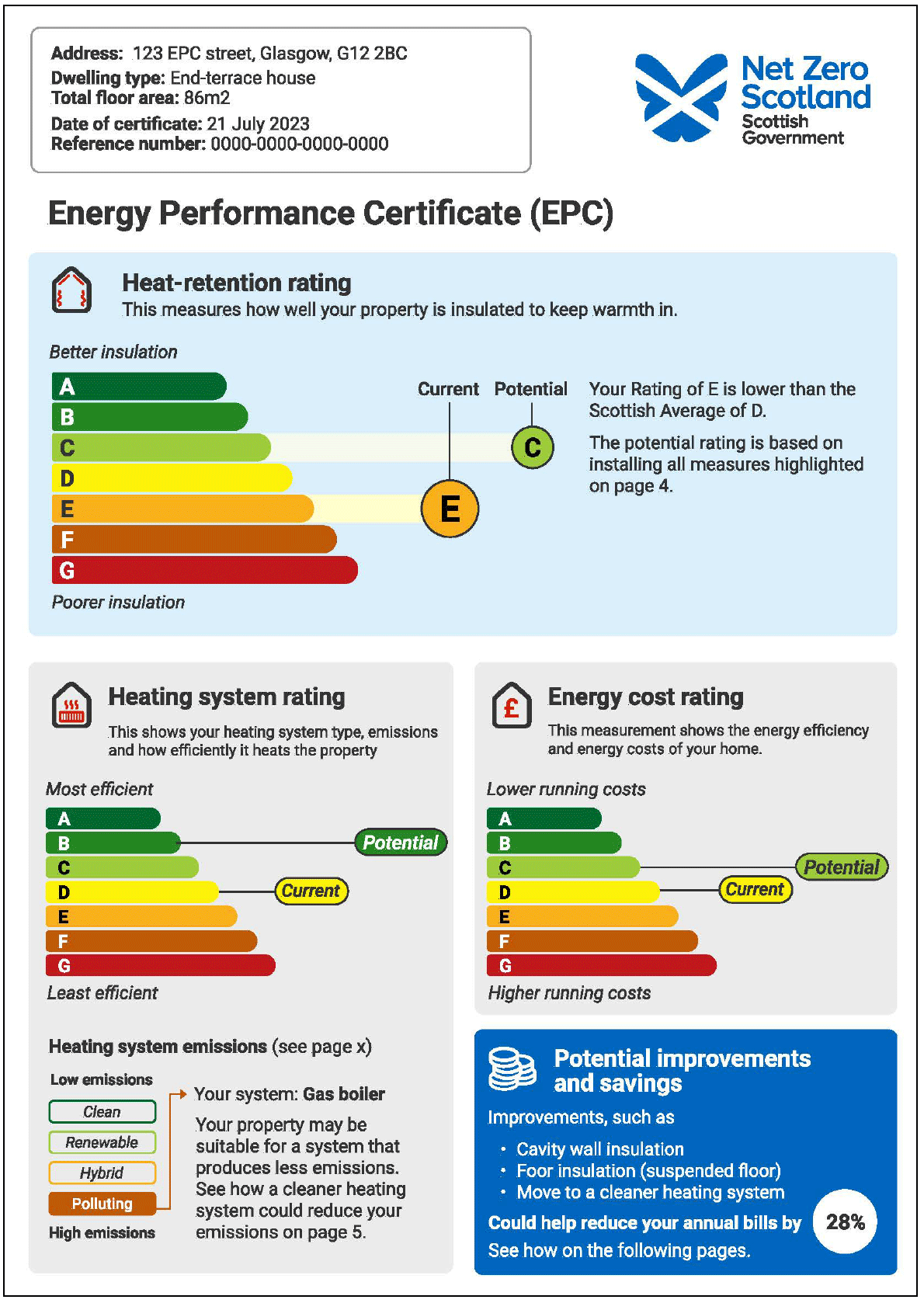
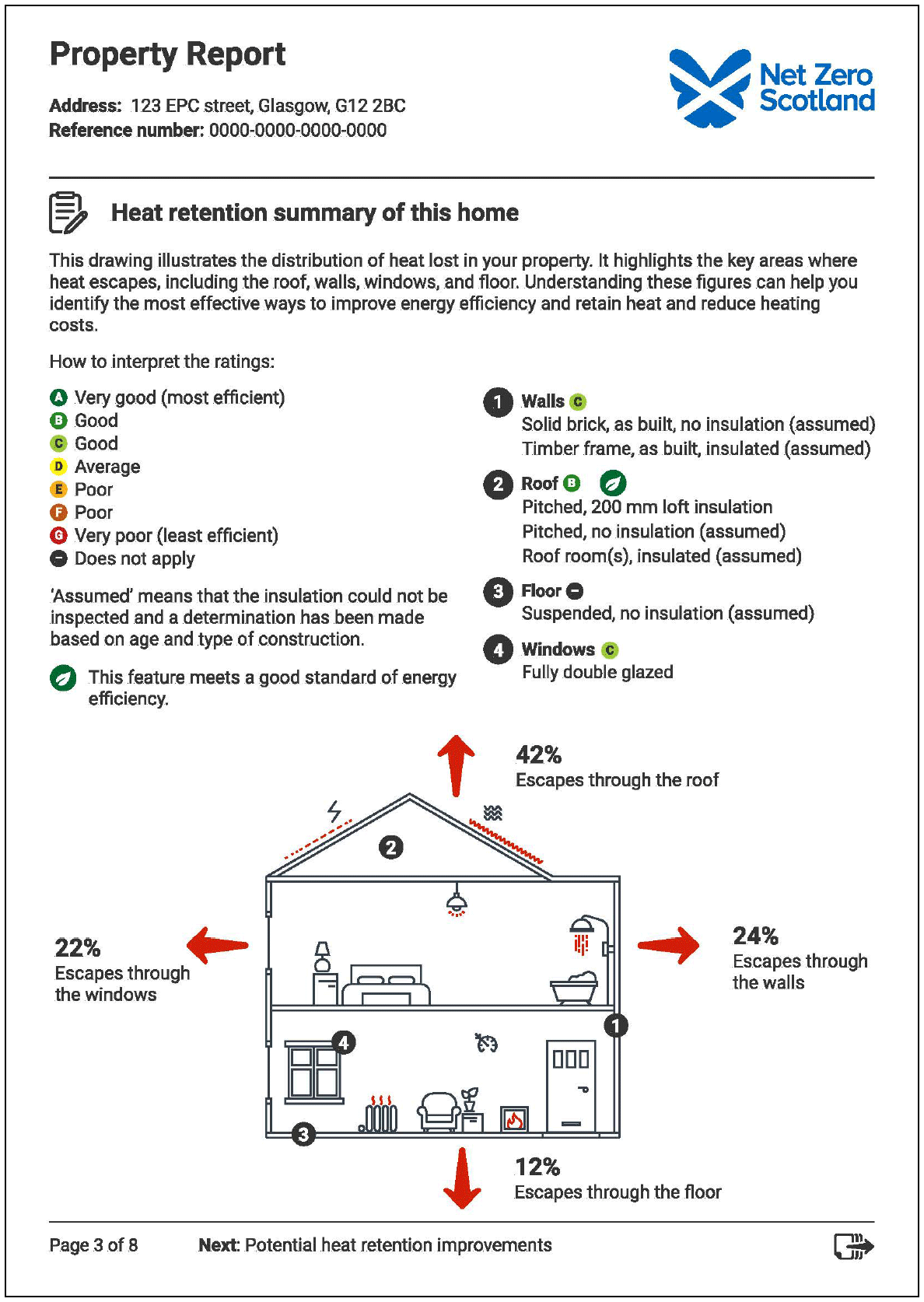
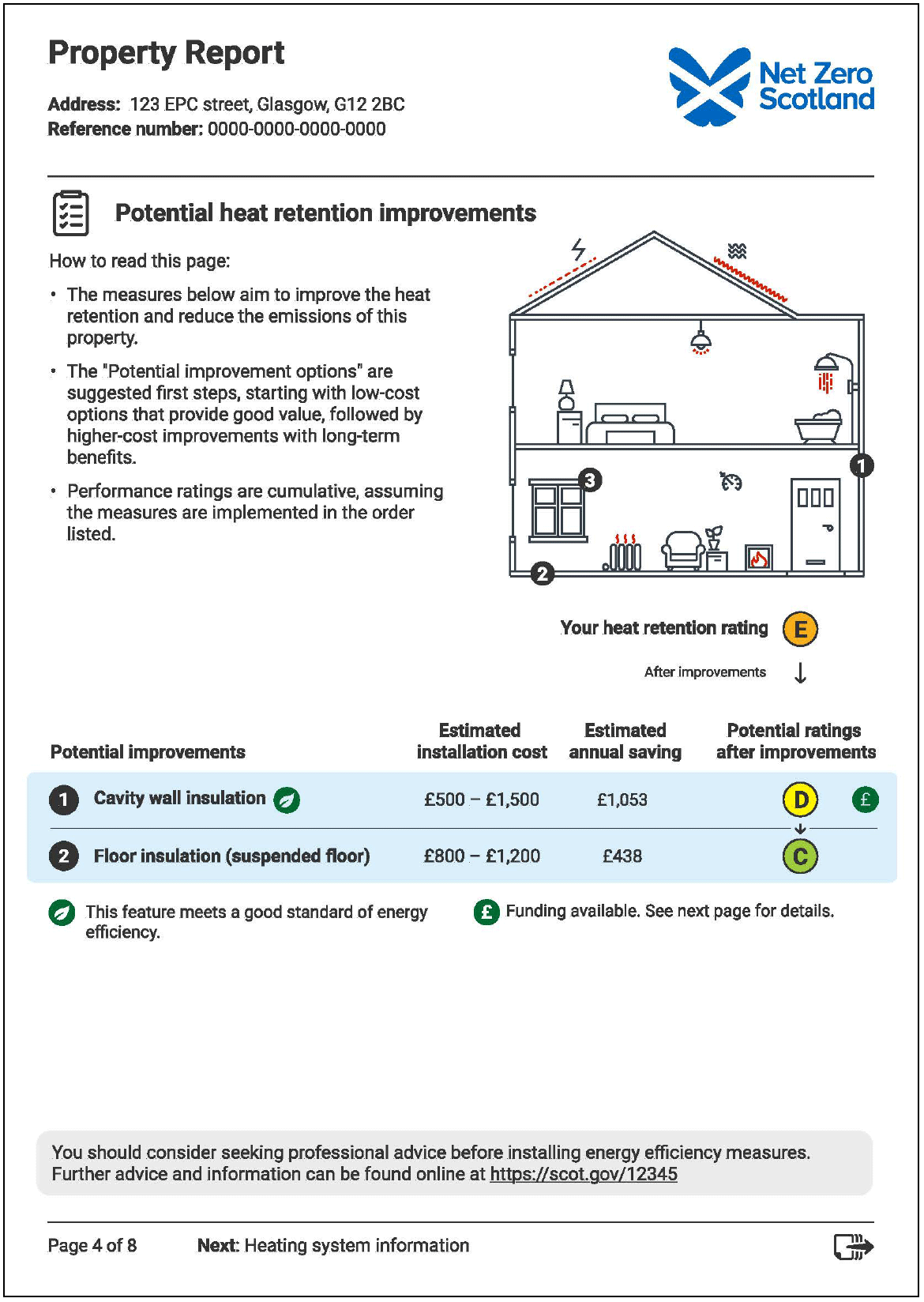
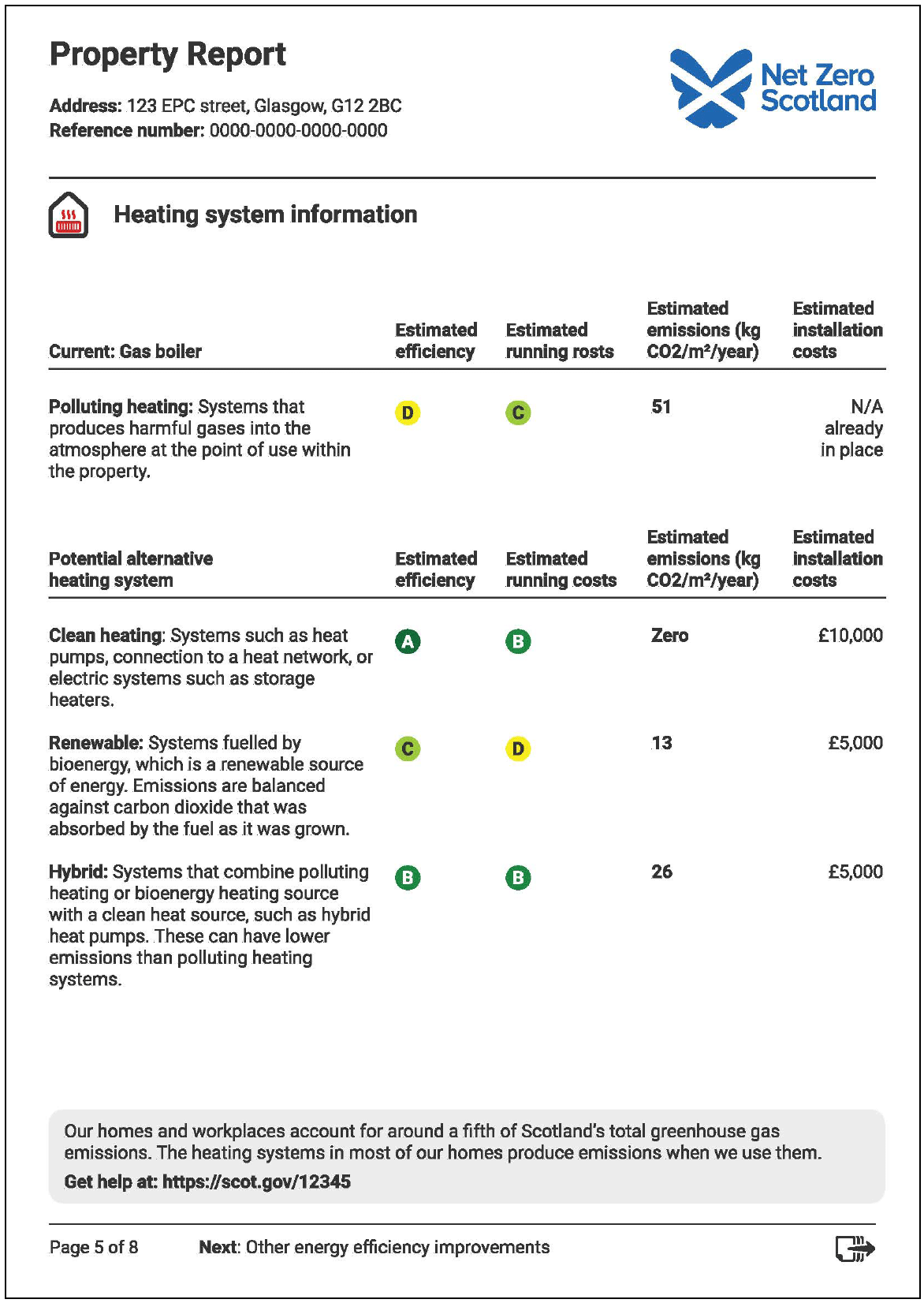
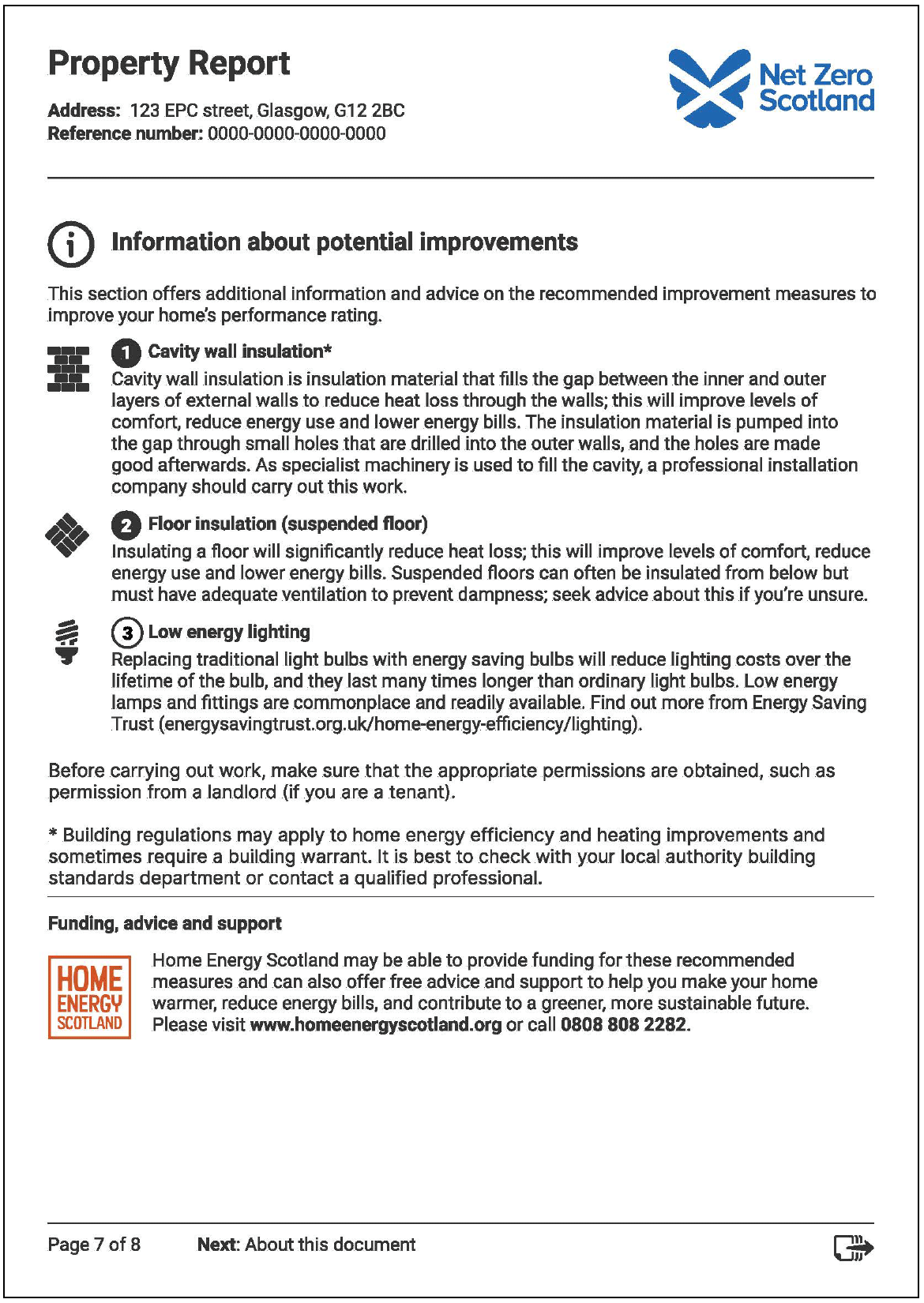
Summary – Domestic EPCs
We Will Do:
1. Introduce a reformed set of three domestic EPC ratings:
- Heat Retention Rating, based on how well the building retains heat – i.e. its heat demand / fabric efficiency
- Heating System Type Rating, comprising ratings for the emissions category, thermal efficiency and running cost
- Energy Cost Rating, based on the total cost to run the property (in line with the current Energy Efficiency Rating / EPC Rating)
2. Introduce a set of secondary metrics to provide information for those interested in particular aspects of the building’s performance.
3. Reform the approach to ‘recommendations’ by:
- Renaming them to ‘potential improvement options’ (to be clearer about their purpose and nature)
- Changing the logic used to display potential improvement measures to focus on improving the building’s Heat Retention Rating (i.e. its fabric)
- Adopting a technology-neutral approach to highlighting and providing basic information about potential non-polluting heating systems.
4. Redesign the EPC so that the information it displays is accessible, clearer, and more engaging.
3.2 Non-Domestic EPCs
We Asked
We proposed to reform non-domestic EPCs to focus on the reduction of direct emissions. The variety of building types and activities in Scotland’s non-domestic building stock mean that it is challenging to identify decarbonisation pathways that can be used across all buildings – on this basis we have focused on providing information about the direct emissions and energy use of the building rather than breaking ratings down into component parts as in the domestic certificate. We proposed the following ratings for non-domestic EPCs:
- Energy Efficiency Rating (A to G) (1-100 based on kg of CO2e/m2/yr) – based on modelled emissions from regulated energy use[7] relative to a reference building to align with the rating system used across the UK;
- Direct Emissions (kg of CO2e/m2/yr) – the building’s modelled direct emissions from regulated energy use to allow a focus on the decarbonisation of individual buildings. (For buildings which only use grid electricity this will be zero);
- Energy Demand (kWh/m2/yr) - the building’s modelled regulated energy use under standardised conditions to allow comparisons between buildings.
Alongside this, we proposed to display the heating fuel type and heating system type more prominently on non-domestic EPCs[8]. This is intended to reflect the importance of moving away from polluting heating systems. This would be accompanied by text noting any relevant regulatory standards.
We proposed different sets of ratings for the domestic and non-domestic EPC. As noted above, this is because domestic and non-domestic EPCs are not comparable and the energy efficiency context of each sector is different. By this we mean that while fabric energy efficiency improvements are a key part of reaching net zero in the domestic sector, other upgrades may need to be prioritised in some areas of the non-domestic sector due to the varied nature of the buildings and their different uses which can be a significant factor on the level of the building’s emissions. This means that focusing on the total direct emissions and energy use is more appropriate than focusing on heat demand.
We have not proposed changes to the Section 63 assessment process, Improvement Plans, or Display Energy Certificates ahead of the Scottish Government’s response to our consultation on proposals for a Heat in Buildings Bill.
We asked the following questions on these proposals:
6. Do you agree with the set of metrics that we propose to display on non-domestic EPCs?
Yes/No/Don’t know
Please explain you view further
7. Are there any additional metrics that you think should be displayed, or any in the proposed set that should not be included?
Should have additional metrics, please explain your view further
Should not be included, please explain your view further
You Said
Key Findings
Across the questions asked in this chapter, the same issues tended to emerge repeatedly.
- Around one in three respondents agreed with the set of ratings proposed to display on non-domestic EPCs (Q6)
Key themes
- Advantages outlined for these ratings included the provision of a clear understanding of the ratings and how they feed into the EPC score. They are a good range of measures to improve building performance. It was also felt these would provide a good foundation for other workstreams and should help incentivise stakeholders to make buildings more energy efficient
- The current ratings are sufficient and no change is needed
- Views were positive on having a relative Energy Rating that would align with the rating system used in other parts of the UK
- There were some calls for consistency between domestic and non-domestic EPCs to help reduce complexity
- There were concerns over the potential costs of retrofit changes, with some requests for additional grant funding to be made available
Next most frequent themes
- The new non-domestic EPC ratings should help to counteract some of the perceived poor quality of data provided under the current ratings
- Some respondents preferred the use of real data rather than modelled data and felt this would provide a more accurate reflection of a building’s performance. There were also some requests for the actual energy costs to be provided rather than being based on standard modelling
- There were some comments that it can be difficult to set ratings for non-domestic buildings because of the variety of building types and uses across the country
- A number of additional ratings for display were suggested by respondents
- There was some criticism over a ‘one-size-fits-all approach, as usage of buildings varies considerably. Additionally, it was felt that some listed buildings and older properties would need to be assessed on an individual basis
We Will Do
The Scottish Government has reflected on the feedback and will implement the revised ratings proposed in the consultation. A key concern raised by businesses in both the consultation and other forums was that the current Scottish non-domestic EPC ratings in Scotland do not currently align with those used in the rest of the UK[9]. This difference is not well understood by the public, and as a result the different rating scales cause confusion to business working across the UK.
In line with our consultation proposal, we intend to address this concern by introducing a rating comparable to the Asset Rating used across the rest of the UK. This would be based on a comparison of the total emissions of the building compared to those of a reference building (a hypothetical building with similar dimensions and usage, but built to a specified standard).
We have noted concerns raised in feedback that showing different ratings on domestic and non-domestic EPCs (as is currently the case) could be confusing and will address this in the design and messaging used on non-domestic EPCs. We will do this by making clear on the EPC the meaning of each rating. As noted in the section above our view is that different ratings are needed on non-domestic and domestic EPCs to reflect the different contexts in which they operate.
Several comments related to concerns over the potential use of ratings to implement proposed HiB regulations. The EPC reform consultation did not include proposals for the use of EPCs in minimum standards or regulations. We consulted separately in 2023 on proposals for a Heat in Buildings Bill. We are still considering our response to that consultation and will give further information on any potential role for EPCs as part of that response.
We have decided to introduce the following ratings and indications on to non-domestic EPCs, in line with the rating system set out in our consultation:
- Energy Efficiency Rating (A to G) kgCO2e/m2/year – based on modelled emissions from regulated energy use[10] relative to a reference building to align with the rating system used across the UK;
- Direct Emissions Rating (kgCO2e/m2/year) – the building’s modelled direct emissions from regulated energy use to allow a focus on the decarbonisation of individual buildings. For buildings which only use grid electricity, or are connected to a heat network, this will be zero;
- Energy Demand Rating (kWh/m2/yr) - the building’s modelled regulated energy use under standardised conditions to allow comparisons between buildings.
The Energy Efficiency Rating will follow the same rating scale as the Asset Rating used on non-domestic EPCs in England, Wales, and Northern Ireland – an A-G letter based on a zero-150+ scale, with kgCO2e/m2/yr also shown. This will allow this rating to be used interchangeably across the UK, which was a key concern we heard from stakeholders responding to the consultation.
The Direct Emissions Rating will provide information about the direct emissions of the building. This allows buildings that use only clean systems for heating, cooling, lighting and ventilation to clearly show this. We do not intend to take account of polluting processes, including process heating, in this indicator, as process heat is regulated separately. We are considering our approach to any proposed regulatory standards for non-domestic buildings in our response to the consultation on proposals for a Heat in Buildings Bill.
The Energy Demand Rating will provide information about the regulated energy use of the building under standardised conditions. This provides another point of comparison for buildings.
In addition, we will retain the Primary Energy Rating currently on non-domestic EPCs. This indicator provides a point of comparison with other countries across the EU.
The non-domestic EPC will also clearly show a Rating for the main Heating System for the building. This will be based upon the same Heating System Type Rating classification as used on the domestic EPC:
- Clean Heating
- Renewable Bioenergy
- Hybrid Systems
- Polluting Heating
Initial versions of the final nondomestic EPC design following phase one of the user testing are set out below. We are finalising how we intend to show these ratings on the EPC, based on further user testing and refinement with consumer groups. The designs below show a potential approach, based on our consumer testing so far. These will be refined further through a second phase of user testing between now and the new EPC regulations coming into force.
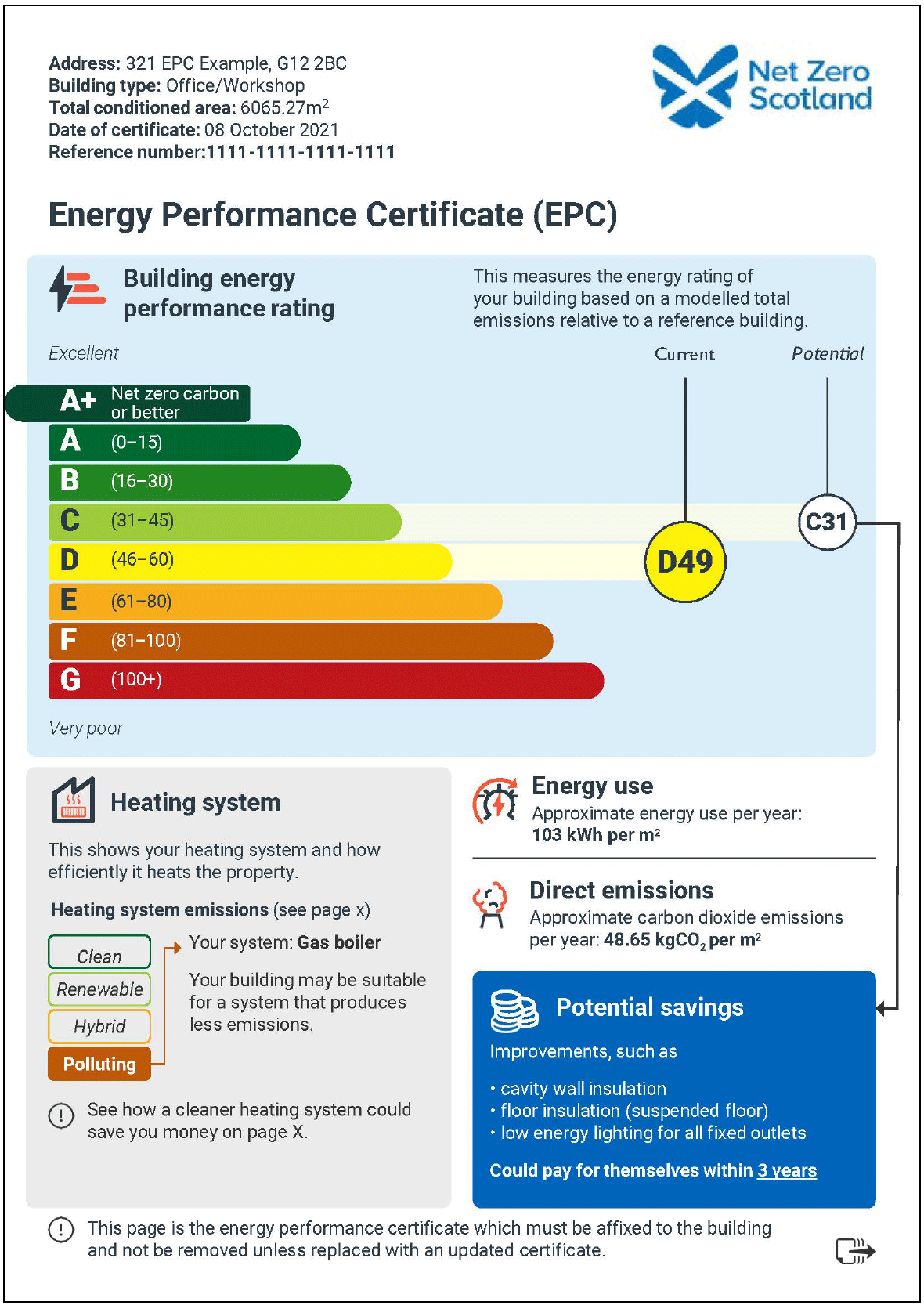 Summary – Non-Domestic EPCs
Summary – Non-Domestic EPCs
We will:
- Introduce a reformed set of three non-domestic EPC ratings:
- Energy Efficiency Rating (A to G) kgCO2e/m2/year, based on modelled emissions from regulated energy use relative to a reference building to align with the rating system used across the UK;
- Direct Emissions Rating (kgCO2e/m2/year), based on the building’s modelled direct emissions from regulated energy use to allow a focus on the decarbonisation of individual buildings. For buildings which only use grid electricity, or those connected to a heat network, this will be zero
- Energy Demand Rating (kWh/m2/yr) - the building’s modelled regulated energy use under standardised conditions to allow comparisons between buildings.
- Clearly show the main heating system of the building and whether it is a polluting system or not.
- Show whether a building is in a heat network zone
- Redesign the EPC so that the information it displays is accessible, clearer, and more engaging.
- Consider additional reforms when responding to the consultation on a Heat in Buildings Bill.
Contact
Email: EPCenquiries@gov.scot
There is a problem
Thanks for your feedback